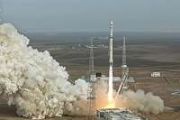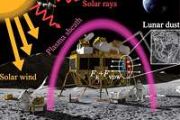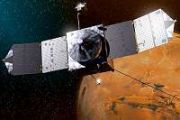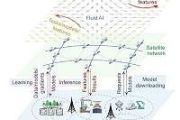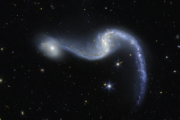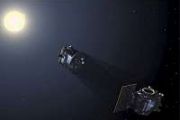
Copernical Team
AST SpaceMobile to Acquire International S-Band Spectrum Rights for Satellite Broadband Expansion
 AST SpaceMobile (NASDAQ: ASTS) has reached an agreement to purchase global S-Band spectrum priority rights under the International Telecommunication Union, enhancing its ability to deliver space-based cellular broadband directly to smartphones for commercial and government use.
Chairman and CEO Abel Avellan said, "Our revolutionary satellites and proprietary ASICs were designed with S-Band
AST SpaceMobile (NASDAQ: ASTS) has reached an agreement to purchase global S-Band spectrum priority rights under the International Telecommunication Union, enhancing its ability to deliver space-based cellular broadband directly to smartphones for commercial and government use.
Chairman and CEO Abel Avellan said, "Our revolutionary satellites and proprietary ASICs were designed with S-Band Unique Martian sulfate points to recent thermal activity and mineral formation
 New research led by the SETI Institute has identified an unusual iron sulfate on Mars that may represent a previously unknown mineral, offering new insights into the planet's thermal and geochemical history. The study, published in Nature Communications, reveals the presence of ferric hydroxysulfate, a mineral that likely formed through heating and oxidation of more common hydrated sulfates.
New research led by the SETI Institute has identified an unusual iron sulfate on Mars that may represent a previously unknown mineral, offering new insights into the planet's thermal and geochemical history. The study, published in Nature Communications, reveals the presence of ferric hydroxysulfate, a mineral that likely formed through heating and oxidation of more common hydrated sulfates. Four astronauts home from space station after splashdown
 An international crew of four astronauts is back home on Earth Saturday after nearly five months aboard the International Space Station, returning safely in a SpaceX capsule.
The spacecraft carrying US astronauts Anne McClain and Nichole Ayers, Japan's Takuya Onishi and Russian cosmonaut Kirill Peskov splashed down off California's coast at 8:44 am local time (1534 GMT).
Their return ma
An international crew of four astronauts is back home on Earth Saturday after nearly five months aboard the International Space Station, returning safely in a SpaceX capsule.
The spacecraft carrying US astronauts Anne McClain and Nichole Ayers, Japan's Takuya Onishi and Russian cosmonaut Kirill Peskov splashed down off California's coast at 8:44 am local time (1534 GMT).
Their return ma Five astronauts leave space station for trip back to Earth
This request seems a bit unusual, so we need to confirm that you're human. Please press and hold the button until it turns completely green. Thank you for your cooperation!
Press and hold the button
If you believe this is an error, please contact our support team.
185.132.36.159 : 52459cb8-d6ad-45f0-ac65-def8f4ea
James Webb Space Telescope discovers evidence of a new planet
 NASA's James Webb Space Telescope has discovered evidence of a giant planet orbiting a star in the solar system closest to Earth, the administration announced Thursday.
The Alpha Centauri triple star system, four light-years from Earth, has long been at the center of scientists' search for life on other planets. This discovery was an important step forward in that search, they said.
NASA's James Webb Space Telescope has discovered evidence of a giant planet orbiting a star in the solar system closest to Earth, the administration announced Thursday.
The Alpha Centauri triple star system, four light-years from Earth, has long been at the center of scientists' search for life on other planets. This discovery was an important step forward in that search, they said. Astronaut Jim Lovell, commander of Apollo 13, dies at 97
 Astronaut Jim Lovell, commander of the Apollo 13 mission to the moon, died Thursday in Illinois, his family announced. He was 97.
Lovell also flew on three other missions: Gemini 7, Gemini 12 and Apollo 8 in the 1960s, and was the first astronaut to go into space that many times.
He died in Lake Forest, a northern Chicago suburb.
"We are saddened to announce the passing of
Astronaut Jim Lovell, commander of the Apollo 13 mission to the moon, died Thursday in Illinois, his family announced. He was 97.
Lovell also flew on three other missions: Gemini 7, Gemini 12 and Apollo 8 in the 1960s, and was the first astronaut to go into space that many times.
He died in Lake Forest, a northern Chicago suburb.
"We are saddened to announce the passing of Martian fractures reveal ancient forces and icy flows
 In a new release from the European Space Agency, Mars Express has revisited the western end of Acheron Fossae, a striking system of deep fissures on Mars shaped by ancient geological upheaval and later sculpted by ice-rich flows.
The orbiter's High Resolution Stereo Camera first captured this area in April 2004, just months into its mission. These latest images reveal the faulted terrain's
In a new release from the European Space Agency, Mars Express has revisited the western end of Acheron Fossae, a striking system of deep fissures on Mars shaped by ancient geological upheaval and later sculpted by ice-rich flows.
The orbiter's High Resolution Stereo Camera first captured this area in April 2004, just months into its mission. These latest images reveal the faulted terrain's US astronaut Jim Lovell, commander of Apollo 13, dead at 97
 US astronaut Jim Lovell, the commander of the Apollo 13 Moon mission which nearly ended in disaster in 1970 after a mid-flight explosion, has died at the age of 97, NASA announced Friday.
The former Navy pilot, who was portrayed by actor Tom Hanks in the 1995 movie "Apollo 13," died in a Chicago suburb on Thursday, the US space agency said in a statement.
The astronaut's "life and work
US astronaut Jim Lovell, the commander of the Apollo 13 Moon mission which nearly ended in disaster in 1970 after a mid-flight explosion, has died at the age of 97, NASA announced Friday.
The former Navy pilot, who was portrayed by actor Tom Hanks in the 1995 movie "Apollo 13," died in a Chicago suburb on Thursday, the US space agency said in a statement.
The astronaut's "life and work Perseverance Rover Delivers Most Detailed Mars Panorama Yet
 NASA's Perseverance rover has produced one of its clearest panoramas to date, revealing a striking view of the Martian landscape from a site known as Falbreen. The mosaic, built from 96 images taken on May 26, 2025, during the rover's 1,516th Martian day, features distant hills up to 40 miles (65 kilometers) away, sand ripples, and the distinct boundary between two geologic units. An enhanced-co
NASA's Perseverance rover has produced one of its clearest panoramas to date, revealing a striking view of the Martian landscape from a site known as Falbreen. The mosaic, built from 96 images taken on May 26, 2025, during the rover's 1,516th Martian day, features distant hills up to 40 miles (65 kilometers) away, sand ripples, and the distinct boundary between two geologic units. An enhanced-co NASA contracts Impulse Space for studies on cost effective orbital transfer solutions
 NASA has chosen Impulse Space to prepare two orbital transfer vehicle (OTV) service studies aimed at identifying more affordable ways to deliver spacecraft to challenging orbital destinations. The work, awarded under NASA's VADR contract through the Launch Services Program, will inform the agency about commercial OTV capabilities for future mission planning.
The studies will examine how Im
NASA has chosen Impulse Space to prepare two orbital transfer vehicle (OTV) service studies aimed at identifying more affordable ways to deliver spacecraft to challenging orbital destinations. The work, awarded under NASA's VADR contract through the Launch Services Program, will inform the agency about commercial OTV capabilities for future mission planning.
The studies will examine how Im 

